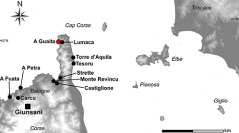

 Comptes Rendus Palevol
13 (4) - Pages 317-331
Comptes Rendus Palevol
13 (4) - Pages 317-331The provenance of a large fraction of the obsidians from the Neolithic site of A Guaita was determined for its three chronocultural layers, between the second half of the 6th millennium and the beginning of the 4th millennium. The elemental composition of 140 samples was obtained by scanning electron microscopy (SEM–EDS) and/or ion beam analysis (PIXE). One hundred and thirty-eight obsidians were found to come from Sardinia and the remaining two from Palmarola Island. This result confirms the almost unique presence of Sardinian obsidians in Corsica and extends this observation to the northern end of the island. The three main Sardinian obsidian types, SA, SB2, and SC, are represented at A Guaita, with a predominance of SB2 and SC. The occurrence of two obsidians from Palmarola suggests that occasional contacts with the Italian Peninsula were in effect from the 6th millennium, in agreement with previous data from ceramics.
Obsidian, Provenance, SEM–EDS, PIXE, Typology, Neolithic, A Guaita, Corsica